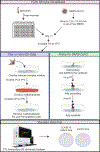Development of a Rapid Focus Reduction Neutralization Test Assay for Measuring SARS-CoV-2 Neutralizing Antibodies
- PMID: 33215858
- PMCID: PMC7864545
- DOI: 10.1002/cpim.116
Development of a Rapid Focus Reduction Neutralization Test Assay for Measuring SARS-CoV-2 Neutralizing Antibodies
Abstract
SARS-CoV-2 is a recently emerged human coronavirus that has escalated to a pandemic. There are currently no approved vaccines for SARS-CoV-2, which causes severe respiratory illness or death. Defining the antibody response to SARS-CoV-2 will be essential for understanding disease progression, long-term immunity, and vaccine efficacy. Here we describe two methods for evaluating the neutralization capacity of SARS-CoV-2 antibodies. The basic protocol is a focus reduction neutralization test (FRNT), which involves immunostaining infected cells with a chromogen deposit readout. The alternate protocol is a modification of the FRNT that uses an infectious clone-derived SARS-CoV-2 virus expressing a fluorescent reporter. These protocols are adapted for use in a high-throughput setting, and are compatible with large-scale vaccine studies or clinical testing. © 2020 Wiley Periodicals LLC Basic Protocol: Focus reduction neutralization test Alternate Protocol: mNeonGreen-based focus reduction neutralization test (FRNT-mNG).
Keywords: SARS-Cov-2; antibody neutralization; high-throughput neutralization assay; neutralizing antibodies; serological assay.
© 2020 Wiley Periodicals LLC.
Conflict of interest statement
Conflicts of Interest
The authors declare no competing interests.
Figures




References
-
- Commission WMH (2019). Report of clustering pneumonia of unknown etiology in Wuhan City.
Publication types
MeSH terms
Substances
Grants and funding
- R38 AI140299/AI/NIAID NIH HHS/United States
- U19 AI090023/AI/NIAID NIH HHS/United States
- U54 AG062334/AG/NIA NIH HHS/United States
- R00 AG049092/AG/NIA NIH HHS/United States
- U19 AI057266/AI/NIAID NIH HHS/United States
- R01 AI127799/AI/NIAID NIH HHS/United States
- UM1 AI148684/AI/NIAID NIH HHS/United States
- R24 AI120942/AI/NIAID NIH HHS/United States
- R01 AI148378/AI/NIAID NIH HHS/United States
- U01 AI151801/AI/NIAID NIH HHS/United States
- P51 OD011132/OD/NIH HHS/United States
- UM1 AI148576/AI/NIAID NIH HHS/United States
LinkOut - more resources
Full Text Sources
Other Literature Sources
Medical
Miscellaneous

